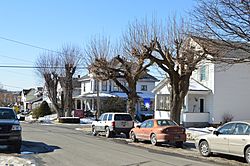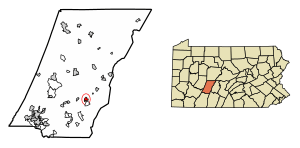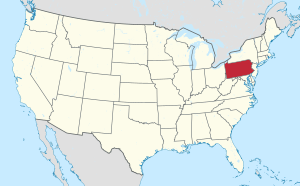Portage, Pennsylvania facts for kids
Quick facts for kids
Portage, Pennsylvania
|
|
|---|---|

Houses on Gillespie Avenue
|
|

Location of Portage in Cambria County, Pennsylvania.
|
|

Location of Pennsylvania in the United States
|
|
| Country | United States |
| State | Pennsylvania |
| County | Cambria |
| Incorporated | 1890 |
| Named for | to portage, or to carry a boat or cargo across land between navigable waters |
| Area | |
| • Total | 0.67 sq mi (1.72 km2) |
| • Land | 0.67 sq mi (1.72 km2) |
| • Water | 0.00 sq mi (0.00 km2) |
| Elevation | 1,686 ft (514 m) |
| Population
(2020)
|
|
| • Total | 2,459 |
| • Density | 3,692.19/sq mi (1,426.26/km2) |
| Time zone | UTC-5 (EST) |
| • Summer (DST) | UTC-4 (EDT) |
| ZIP code |
15946
|
| Area code(s) | 814 |
| FIPS code | 42-62048 |
| GNIS feature ID | 1215031 |
Portage is a small town, called a borough, in Cambria County, Pennsylvania, United States. It's about 10 miles (16 km) southeast of Ebensburg and 22 miles (35 km) southwest of Altoona. Portage is part of the larger Johnstown, Pennsylvania area. In 2023, about 2,388 people lived there.
Contents
History of Portage
The story of Portage began in 1834 with the Allegheny-Portage Railroad (APRR). This railroad helped people carry boats and goods over land between different waterways. Because of its location at the bottom of "Inclined Plane No. 2" of the APRR, Portage was first called “Foot of Two.” The APRR even built its main offices and shops here. There was also a hotel called the Washington House for travelers.
The name “Foot of Two” was later changed to “Portage.” The word portage means carrying boats, goods, etc., overland from one body of water to another.
Today, Pennsylvania Route 53 follows the old route of the APRR through Portage. By 1852, Inclined Plane No. 2 was no longer needed because trains had become more advanced.
Railroads and Growth
By 1854, the Allegheny Portage Railroad became old-fashioned. This was because the Pennsylvania Railroad could travel over the Allegheny Mountains much faster and safer. Another company, the New Portage Railroad, tried to compete, but the Pennsylvania Railroad bought it in 1857 and closed it down.
A few years after the Pennsylvania Railroad opened, a special stop was built in Portage. Trains could get water and wood for their engines here. Portage had a lot of lumber and coal, so many companies started cutting down trees and mining coal in the area. These new industries caused the town to grow quickly. By the 1860s, a train station was built for passengers.
Portage Township was created in 1878. Then, on October 7, 1890, the borough of Portage was officially formed.
In the 1890s, the Pennsylvania Railroad changed its route, and a new train station was built on Washington Avenue. Portage continued to grow, reaching its largest population of 4,804 people in 1920. The Washington Avenue station stayed open until 1926, when an even newer station was built on Lee Street.
Sonman Mine Explosion
On July 15, 1940, a terrible event known as the Sonman Mine Explosion happened near Portage. A total of 63 miners died when methane gas exploded. In 1960, a memorial was built to remember these miners. It was later moved to Crichton-McCormick Park in Portage. The Portage Station Museum has a film about this disaster called "63 Men Down: The Story of the Sonman Mine Explosion." The museum also shows exhibits about coal mining and railroads in the area.
Changes in Portage
On November 17, 1953, the Pennsylvania Railroad stopped offering passenger train service to Portage. The station closed completely in 1954. The population of Portage stayed around 4,000 until the late 1970s. After that, the population dropped a lot. This happened because many coal mines in the area closed. Also, the steel industry in nearby Johnstown slowed down after the 1977 Johnstown Flood and because of steel imports from other countries.
To celebrate the town's 100th birthday, a festival called "Summerfest" was started. It happens every year on the second weekend of August. The festival has many traditions, like serving different ethnic foods and holding a church service on Sunday morning. Another yearly event is the community yard sale, organized by the Portage Area Historical Society. It takes place on the second Saturday in June.
The Portage Historic District was added to the National Register of Historic Places in 1995. This means it's recognized for its important history.
On May 10, 1994, Portage adopted a special rule called a home rule charter. This means the town can make more of its own decisions about how it's run, instead of following all state rules for boroughs. This rule officially started on January 1, 1996. Even though it has home rule, it still uses "Borough of Portage" as its official name.
Portage Volunteer Fire Company
The Portage Volunteer Fire Company was started in 1906. Back then, it was a small barn with a horse-drawn fire engine. In 1936, they got a new, modern fire engine. They were one of the first fire companies to have such an engine and began helping other nearby towns.
As the company grew, they needed more space. In 1977, they built a larger building that also houses the Portage Borough Police Department. In 2009, the Cassandra Volunteer Fire Company and Portage Volunteer Fire Company joined together. This helped them serve the community better. In 2015, the Wilmore Volunteer Fire Company also merged with them.
Today, the Portage Volunteer Fire Company operates from two stations. They have several fire trucks and support vehicles to help keep the community safe.
Notable People from Portage
- Len Chappell, a professional basketball player
- Col. Edgar Wittan, a decorated World War II veteran, pilot, and commander
Geography of Portage
Portage is located in the southeastern part of Cambria County. It sits in the valley of the Little Conemaugh River.
The United States Census Bureau says that Portage covers a total area of about 0.67 square miles (1.7 square kilometers). All of this area is land.
Population and Demographics
| Historical population | |||
|---|---|---|---|
| Census | Pop. | %± | |
| 1880 | 274 | — | |
| 1890 | 564 | 105.8% | |
| 1900 | 816 | 44.7% | |
| 1910 | 2,954 | 262.0% | |
| 1920 | 4,804 | 62.6% | |
| 1930 | 4,432 | −7.7% | |
| 1940 | 4,123 | −7.0% | |
| 1950 | 4,371 | 6.0% | |
| 1960 | 3,933 | −10.0% | |
| 1970 | 4,151 | 5.5% | |
| 1980 | 3,510 | −15.4% | |
| 1990 | 3,105 | −11.5% | |
| 2000 | 2,837 | −8.6% | |
| 2010 | 2,638 | −7.0% | |
| 2020 | 2,459 | −6.8% | |
| Sources: | |||
In 2000, there were 2,837 people living in Portage. The population density was about 4,262.7 people per square mile (1,645.8 per square kilometer). Most residents in Portage are of Polish or Slovak descent.
The population has changed over the years. It grew a lot in the early 1900s, reaching its highest point in 1920. Since the late 1970s, the population has slowly decreased.
See also
In Spanish: Portage (Pensilvania) para niños

